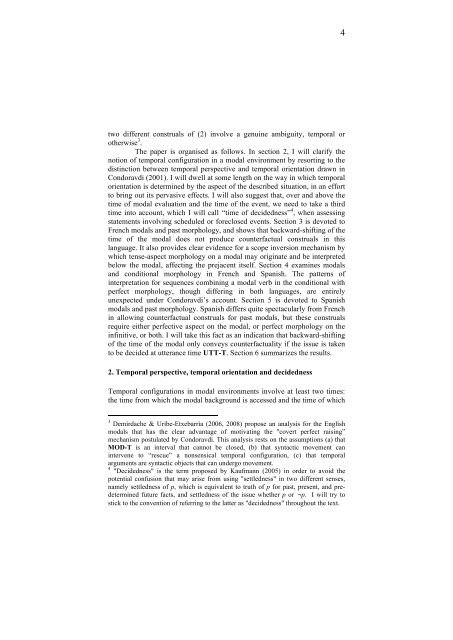On modal tenses and tensed modals - UMR 7023 - CNRS
On modal tenses and tensed modals - UMR 7023 - CNRS
On modal tenses and tensed modals - UMR 7023 - CNRS
You also want an ePaper? Increase the reach of your titles
YUMPU automatically turns print PDFs into web optimized ePapers that Google loves.
two different construals of (2) involve a genuine ambiguity, temporal or<br />
otherwise 3 .<br />
The paper is organised as follows. In section 2, I will clarify the<br />
notion of temporal configuration in a <strong>modal</strong> environment by resorting to the<br />
distinction between temporal perspective <strong>and</strong> temporal orientation drawn in<br />
Condoravdi (2001). I will dwell at some length on the way in which temporal<br />
orientation is determined by the aspect of the described situation, in an effort<br />
to bring out its pervasive effects. I will also suggest that, over <strong>and</strong> above the<br />
time of <strong>modal</strong> evaluation <strong>and</strong> the time of the event, we need to take a third<br />
time into account, which I will call “time of decidedness” 4 , when assessing<br />
statements involving scheduled or foreclosed events. Section 3 is devoted to<br />
French <strong>modal</strong>s <strong>and</strong> past morphology, <strong>and</strong> shows that backward-shifting of the<br />
time of the <strong>modal</strong> does not produce counterfactual construals in this<br />
language. It also provides clear evidence for a scope inversion mechanism by<br />
which tense-aspect morphology on a <strong>modal</strong> may originate <strong>and</strong> be interpreted<br />
below the <strong>modal</strong>, affecting the prejacent itself. Section 4 examines <strong>modal</strong>s<br />
<strong>and</strong> conditional morphology in French <strong>and</strong> Spanish. The patterns of<br />
interpretation for sequences combining a <strong>modal</strong> verb in the conditional with<br />
perfect morphology, though differing in both languages, are entirely<br />
unexpected under Condoravdi’s account. Section 5 is devoted to Spanish<br />
<strong>modal</strong>s <strong>and</strong> past morphology. Spanish differs quite spectacularly from French<br />
in allowing counterfactual construals for past <strong>modal</strong>s, but these construals<br />
require either perfective aspect on the <strong>modal</strong>, or perfect morphology on the<br />
infinitive, or both. I will take this fact as an indication that backward-shifting<br />
of the time of the <strong>modal</strong> only conveys counterfactuality if the issue is taken<br />
to be decided at utterance time UTT-T. Section 6 summarizes the results.<br />
2. Temporal perspective, temporal orientation <strong>and</strong> decidedness<br />
Temporal configurations in <strong>modal</strong> environments involve at least two times:<br />
the time from which the <strong>modal</strong> background is accessed <strong>and</strong> the time of which<br />
3 Demirdache & Uribe-Etxebarría (2006, 2008) propose an analysis for the English<br />
<strong>modal</strong>s that has the clear advantage of motivating the "covert perfect raising”<br />
mechanism postulated by Condoravdi. This analysis rests on the assumptions (a) that<br />
MOD-T is an interval that cannot be closed, (b) that syntactic movement can<br />
intervene to “rescue” a nonsensical temporal configuration, (c) that temporal<br />
arguments are syntactic objects that can undergo movement.<br />
4 "Decidedness" is the term proposed by Kaufmann (2005) in order to avoid the<br />
potential confusion that may arise from using "settledness" in two different senses,<br />
namely settledness of p, which is equivalent to truth of p for past, present, <strong>and</strong> predetermined<br />
future facts, <strong>and</strong> settledness of the issue whether p or ¬p. I will try to<br />
stick to the convention of referring to the latter as "decidedness" throughout the text.<br />
4

















